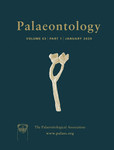Reg. Charity No. 1168330

Conodont elements, consisting of crown and basal tissue are the well‐known fossilized hard parts of Conodonta (extinct marine chordates), but the taphonomic processes leading to decomposition or remineralization of the basal tissue are not well understood. Here we focus on the taphonomy of basal tissue, reviewing the published record and describing new material from Asia and Europe (248 occurrences globally). These include crown and basal tissue in conjunction, and isolated basal bodies showing different stages of preservation. Some isolated specimens resemble phosphate rings similar to those assigned to Phosphannulus universalis. High‐resolution biostratigraphy indicates that the lamellar type of conodont basal tissue is found in all facies and depositional environments. Other basal tissue types, described in the literature as tubular, mesodentine, spherulitic or lamellar with canalules, are limited to the early Palaeozoic and found exclusively in siliciclastic deposits (with the exception of spherulitic tissue). Although the stratigraphic record of basal tissue spans the range of Euconodonta (Cambrian–Triassic), this study shows that most of the isolated plate and ring‐like structures are derived from early Palaeozoic coniform conodonts. Basal tissue of platform‐type elements has a much more fragile shape and is therefore rarely preserved as a recognizable isolated unit.